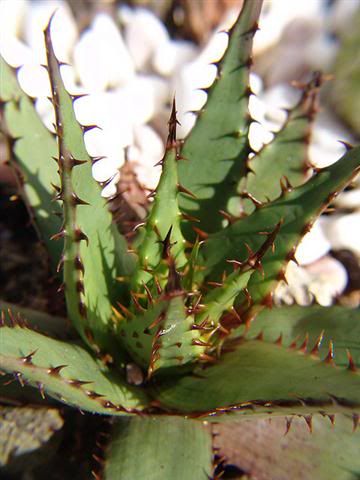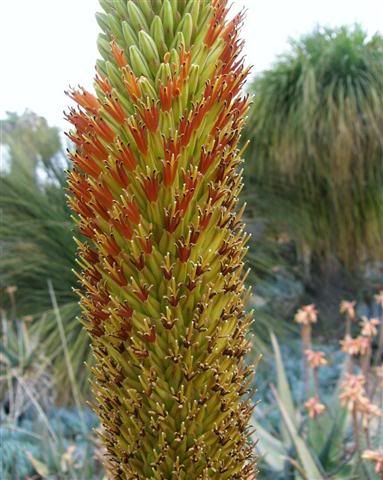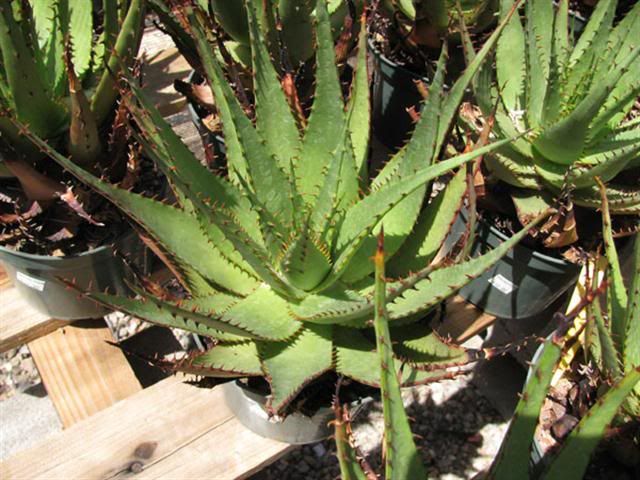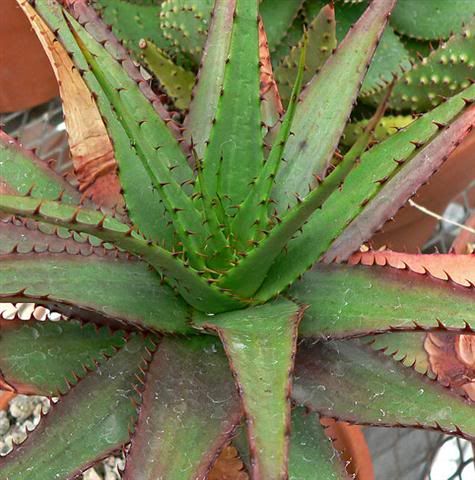Aloe broomii (Алое бруми) е acaulescent (без стебло) кој потекнува од карпестите падини во централниот дел на Јужна Африка. Името “broomii“ доаѓа од презимето “Broom" на човекот кој прв почнал да го собира. Кога ќе расцвета, овој сукулент има уникатна карактеристика која не е својствена за нуту еден друг вид на Aloe. Цветчињата не му се гледаат, бидејќи се целосно покриени со долги цветни ливчиња. Видливи се само прашниците и чашките.
Сукулент на денот 129/11 е...
Aloe broomii
Фамилија: Asphodelaceae
Род: Aloe
Вид: A. broomii
Народнo имe: Mountain Aloe, Snake Aloe
Синоним/и: Aloe broomii var. broomii
Потекло: Јужна Африка
Боја на цветот: Портокалова, златна, зелена
Сезона на цветање: Крај на зима, почеток на пролет
Висина: до 45-90 cm
Дијаметар: до 90 cm
Род: Aloe
Вид: A. broomii
Народнo имe: Mountain Aloe, Snake Aloe
Синоним/и: Aloe broomii var. broomii
Потекло: Јужна Африка
Боја на цветот: Портокалова, златна, зелена
Сезона на цветање: Крај на зима, почеток на пролет
Висина: до 45-90 cm
Дијаметар: до 90 cm
Одгледување:
Се одгледува во супстрат со добра дренажа, на места изложени на директно сонце. Во периодот кога расте, се полева умерено. Во зима супстратот се одржува сув. Во тој период се препорачува да се чува во простории на температура од околу 10°C. Отпорен е на смрзнување и во краток временски интервал може да толерира температури и до околу -4°C.
Се одгледува во супстрат со добра дренажа, на места изложени на директно сонце. Во периодот кога расте, се полева умерено. Во зима супстратот се одржува сув. Во тој период се препорачува да се чува во простории на температура од околу 10°C. Отпорен е на смрзнување и во краток временски интервал може да толерира температури и до околу -4°C.
Размножување:
Се размножува со семе и со израстоци.
Се размножува со семе и со израстоци.
Надворешен линк: Овде
Во областа Steynburg, кафеавата течност која се добива од варени лисја на Aloe broomii фармерите ја користат против крлежите, како средство за дезинфекција, како лек за уво кај овците и за премачкување на стоката.
Освен основниот вид на овој сукулент, има уште една сорта која се разликува по тоа што има пократки цветни ливчиња, а со тоа и цветчиња кои се видливи...
Aloe broomii var. tarkaensis
Фамилија: Asphodelaceae
Род: Aloe
Вид: A. broomii var. tarkaensis
Народнo имe: Mountain Aloe, Snake Aloe
Потекло: Јужна Африка
Боја на цветот: Портокалова, златна, зелена
Сезона на цветање: Крај на зима, почеток на пролет
Висина: до 45-90 cm
Дијаметар: до 90 cm
Род: Aloe
Вид: A. broomii var. tarkaensis
Народнo имe: Mountain Aloe, Snake Aloe
Потекло: Јужна Африка
Боја на цветот: Портокалова, златна, зелена
Сезона на цветање: Крај на зима, почеток на пролет
Висина: до 45-90 cm
Дијаметар: до 90 cm
Едно несекојдневно Портокалово јаболко може да видите овде. Него, заедно со уште 81 други видови на кактуси, сукуленти и некои други ксерофити, детално презентирани, може да ги најдете во КАКТИПЕДИЈА.
Family : Asphodelaceae (asphodel family)
Common names : mountain aloe, snake aloe (Eng.); bergaalwee, slangaalwyn (Afr.)
Aloe broomii has a unique feature that no other aloe has - the flowers and buds cannot be seen when the flower is fully open because they are completely hidden by longer bracts. All that we can see of the flowers are the stamens and stigmas sticking out beyond the bracts.
Description
Aloe broomii is a short-stemmed, robust aloe reaching a height of 1.5 m, including the inflorescence. It is usually solitary, but occasionally the heads divide to form groups of up to 3 rosettes. The leaves are green, with reddish brown teeth along the margins, and are arranged in a dense rosette.
The inflorescence is a densely flowered, un-branched (simple) raceme 1.0 - 1.5 m long. The flowers are pale greenish yellow and 20 - 25 mm long. The buds are completely hidden behind large bracts that are densely arranged like tiles on a roof. The flowers open in an approx. 100 mm wide band from the bottom of the inflorescence upwards, but all that can be seen of them are the stamens and stigmas that stick out beyond the bracts. It flowers during spring, and the seed ripens during summer.
There are two varieties of Aloe broomii var. broomii and var. tarkaensis. They are distinguished by the size of their floral bracts: var. tarkaensis has shorter bracts so that more of the flowers and buds are exposed; it also has broader leaves, and flowers in late summer.
Conservation status
Aloe broomii is not a threatened species, it is still common throughout its distribution range.
Distribution and habitat
This species has a wide distribution. It is found on rocky slopes in hilly parts of the central interior of southern Africa at altitudes of 1 000-2 000 m, from the top of the southern escarpment near Beaufort West in the Northern Cape, to near Tarkastad in the Eastern Cape to the Free State in the north, and in Lesotho. Rainfall in this region is mainly during summer, ranging from 300 to 500 mm per annum.
©Philip Nel
Derivation of name and historical aspects
Aloe broomii was collected by Dr R. Broom in 1905 at Pampoenpoort, which is between Carnarvon and Victoria West, so this wonderful species was named after the man who was the first to collect it. It earned the common name snake aloe because of its long, slender, snake-like inflorescence.
Ecology
Aloes produce a lot of nectar that attracts bees, sunbirds and ants. Their light, winged seeds are dispersed by the wind. The seeds are often parasitized by very small maize and rice weevils ( Sitophilus spp.) that leave small round holes in the seeds.
Use and cultural aspects
In the Steynburg District farmers use the brownish fluid that comes from the boiled leaves of Aloe broomii to kill ticks, and as a disinfectant, an ear remedy for sheep, and a dip for cattle. A dessertspoonful of juice from the boiled leaves given to a horse makes the blood temporarily so bitter that any ticks on the animal fall off.
Growing Aloe broomii
Aloe broomii is an ideal water-wise plant, especially in arid and semi-arid regions, and it is frost resistant. It makes an excellent focal point and structural plant in landscaped gardens, and is a good choice for a rock garden.
Grow Aloe broomii in a sunny position in well-drained (sandy), fertile, soil. Add plenty of compost and bone meal to the planting hole and give the newly planted aloe a regular deep watering for the first few weeks - this will encourage strong root growth. As the plant gets established, reduce the amount of water and don't water at all during the rainy season. Established plants can take care of themselves as they store water in their leaves and are well adapted to an arid environment. Add a thick mulch of compost to both feed the plant and keep the roots cool. Mulch will also reduce evaporation and decrease weed growth.
Propagate Aloe broomii from fresh seed treated with the fungicide Apron C (a.i. metalaxyl) and sow in summer. Use a sterile, well-drained, sandy medium and cover lightly with a 2 mm layer of sand. Keep moist and place in a warm, sheltered position that receives good light but no direct sun, and with free movement of air. Germination is usually within 2-3 weeks during the warm summer months. When germinated, harden them off by gradually exposing them to direct sunlight. ~Censored~ out when the seedlings are 20-30 mm tall, pot them into a soil mixture consisting of 2 parts sand : 1 part loam : 1 part compost. Take care not to over-water the seedlings, too much water may cause them to rot.
Aloe broomii is susceptible to snout weevil and scale infestation, and to fungal infections. Snout weevils can be combated with Ripcord (a.i. cypermethrin) during late October and November when the eggs are laid. Scale insects can be treated with mineral oils Oleum or Alboleum. But biological control is best: make your garden attractive to wildlife, such as lizards, ladybirds and praying mantids - they prey on many garden pests, and will reduce the chances of pest infestations. A healthy, well-grown plant in the correct position has less chance of developing a fungal infection, but if the plant does get infected, treat it with a fungicide.
Acknowledgements
Werner Voigt and Ernst van Jaarsveld for helping with information on Aloe broomii in general and on its cultivation and propagation, and for sharing their field observations and experience; Alice Notten for helping with the writing of the article; Philip Nel for sharing his photograph of Aloe broomii in habitat.
References and further reading
Germishuizen, G. & Meyer, N.L. (eds). 2003. Plants of southern Africa : an annotated checklist. Strelitzia 14. National Botanical Institute, Pretoria.
Jeppe, B. 1969. South African aloes. Parnell, Cape Town.
Pole Evans, I.B. 1936. Aloe broomii (Liliaceae). The Flowering Plants of South Africa 16: t. 605.
Reynolds, G.W. 1974. The aloes of South Africa. Balkema, Cape Town, Rotterdam.
Van Jaarsveld, E.J. 2000. Wonderful water-wise gardening. Tafelberg, Cape Town.
Van Wyk, B-E. & Smith, G. 1994. Guide to the aloes of South Africa. Briza Publications, Pretoria.
http://www.lithops.n...omii_detail.htm
Common names : mountain aloe, snake aloe (Eng.); bergaalwee, slangaalwyn (Afr.)
Aloe broomii has a unique feature that no other aloe has - the flowers and buds cannot be seen when the flower is fully open because they are completely hidden by longer bracts. All that we can see of the flowers are the stamens and stigmas sticking out beyond the bracts.
Description
Aloe broomii is a short-stemmed, robust aloe reaching a height of 1.5 m, including the inflorescence. It is usually solitary, but occasionally the heads divide to form groups of up to 3 rosettes. The leaves are green, with reddish brown teeth along the margins, and are arranged in a dense rosette.
The inflorescence is a densely flowered, un-branched (simple) raceme 1.0 - 1.5 m long. The flowers are pale greenish yellow and 20 - 25 mm long. The buds are completely hidden behind large bracts that are densely arranged like tiles on a roof. The flowers open in an approx. 100 mm wide band from the bottom of the inflorescence upwards, but all that can be seen of them are the stamens and stigmas that stick out beyond the bracts. It flowers during spring, and the seed ripens during summer.
There are two varieties of Aloe broomii var. broomii and var. tarkaensis. They are distinguished by the size of their floral bracts: var. tarkaensis has shorter bracts so that more of the flowers and buds are exposed; it also has broader leaves, and flowers in late summer.
Conservation status
Aloe broomii is not a threatened species, it is still common throughout its distribution range.
Distribution and habitat
This species has a wide distribution. It is found on rocky slopes in hilly parts of the central interior of southern Africa at altitudes of 1 000-2 000 m, from the top of the southern escarpment near Beaufort West in the Northern Cape, to near Tarkastad in the Eastern Cape to the Free State in the north, and in Lesotho. Rainfall in this region is mainly during summer, ranging from 300 to 500 mm per annum.
©Philip Nel
Derivation of name and historical aspects
Aloe broomii was collected by Dr R. Broom in 1905 at Pampoenpoort, which is between Carnarvon and Victoria West, so this wonderful species was named after the man who was the first to collect it. It earned the common name snake aloe because of its long, slender, snake-like inflorescence.
Ecology
Aloes produce a lot of nectar that attracts bees, sunbirds and ants. Their light, winged seeds are dispersed by the wind. The seeds are often parasitized by very small maize and rice weevils ( Sitophilus spp.) that leave small round holes in the seeds.
Use and cultural aspects
In the Steynburg District farmers use the brownish fluid that comes from the boiled leaves of Aloe broomii to kill ticks, and as a disinfectant, an ear remedy for sheep, and a dip for cattle. A dessertspoonful of juice from the boiled leaves given to a horse makes the blood temporarily so bitter that any ticks on the animal fall off.
Growing Aloe broomii
Aloe broomii is an ideal water-wise plant, especially in arid and semi-arid regions, and it is frost resistant. It makes an excellent focal point and structural plant in landscaped gardens, and is a good choice for a rock garden.
Grow Aloe broomii in a sunny position in well-drained (sandy), fertile, soil. Add plenty of compost and bone meal to the planting hole and give the newly planted aloe a regular deep watering for the first few weeks - this will encourage strong root growth. As the plant gets established, reduce the amount of water and don't water at all during the rainy season. Established plants can take care of themselves as they store water in their leaves and are well adapted to an arid environment. Add a thick mulch of compost to both feed the plant and keep the roots cool. Mulch will also reduce evaporation and decrease weed growth.
Propagate Aloe broomii from fresh seed treated with the fungicide Apron C (a.i. metalaxyl) and sow in summer. Use a sterile, well-drained, sandy medium and cover lightly with a 2 mm layer of sand. Keep moist and place in a warm, sheltered position that receives good light but no direct sun, and with free movement of air. Germination is usually within 2-3 weeks during the warm summer months. When germinated, harden them off by gradually exposing them to direct sunlight. ~Censored~ out when the seedlings are 20-30 mm tall, pot them into a soil mixture consisting of 2 parts sand : 1 part loam : 1 part compost. Take care not to over-water the seedlings, too much water may cause them to rot.
Aloe broomii is susceptible to snout weevil and scale infestation, and to fungal infections. Snout weevils can be combated with Ripcord (a.i. cypermethrin) during late October and November when the eggs are laid. Scale insects can be treated with mineral oils Oleum or Alboleum. But biological control is best: make your garden attractive to wildlife, such as lizards, ladybirds and praying mantids - they prey on many garden pests, and will reduce the chances of pest infestations. A healthy, well-grown plant in the correct position has less chance of developing a fungal infection, but if the plant does get infected, treat it with a fungicide.
Acknowledgements
Werner Voigt and Ernst van Jaarsveld for helping with information on Aloe broomii in general and on its cultivation and propagation, and for sharing their field observations and experience; Alice Notten for helping with the writing of the article; Philip Nel for sharing his photograph of Aloe broomii in habitat.
References and further reading
Germishuizen, G. & Meyer, N.L. (eds). 2003. Plants of southern Africa : an annotated checklist. Strelitzia 14. National Botanical Institute, Pretoria.
Jeppe, B. 1969. South African aloes. Parnell, Cape Town.
Pole Evans, I.B. 1936. Aloe broomii (Liliaceae). The Flowering Plants of South Africa 16: t. 605.
Reynolds, G.W. 1974. The aloes of South Africa. Balkema, Cape Town, Rotterdam.
Van Jaarsveld, E.J. 2000. Wonderful water-wise gardening. Tafelberg, Cape Town.
Van Wyk, B-E. & Smith, G. 1994. Guide to the aloes of South Africa. Briza Publications, Pretoria.
http://www.lithops.n...omii_detail.htm





No comments:
Post a Comment